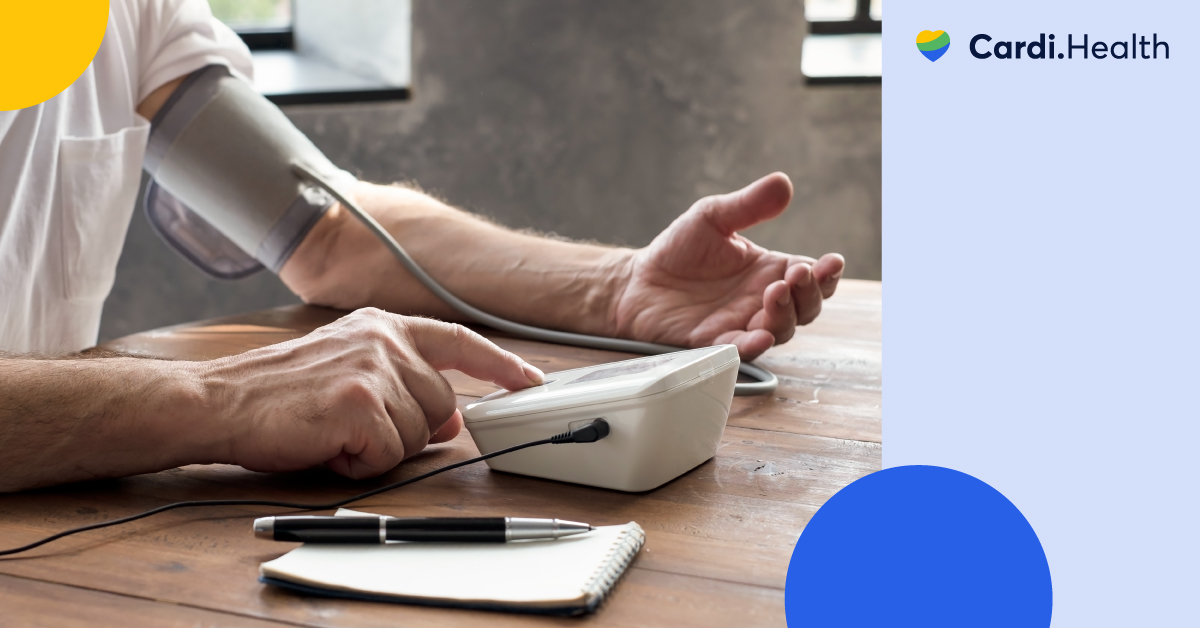How to Read Blood Pressure: Know What Your Numbers Mean
Blood pressure is an important metric when considering your health. High blood pressure can be a quiet disease, but it can lead to serious health complications like stroke, heart attack, and kidney disease.
If you’re living with or at risk of high blood pressure (hypertension), you need to know how to understand blood pressure readings. This article will show you exactly how to do it.

Master your heart health now
Take part in our 60sec quiz and get a heart health plan tailored just for you.
Contents
Basics of Blood Pressure Readings
Blood pressure is measured using a blood pressure monitor (or sphygmomanometer). A cuff is tightened around your upper arm, and the slight movements that your blood makes to squeeze past the inflated cuff are used to determine your blood pressure.
Previously, what counted as normal BP was age-dependent. The normal blood pressure for a 75-year-old male was different from a 40-year-old. However, new guidelines have made it so that all ages share the same blood pressure categories. A blood pressure reading over 130/80mmHg counts as hypertension.
Start managing your heart health now!
Find out what works for you with this 60sec quiz.

What is systolic blood pressure?
Your systolic blood pressure is the first of the two blood pressure numbers. It represents the force, or pressure, that is exerted on the walls of the blood vessels as your heart contracts.
Because systolic blood pressure is always the highest number, it puts more stress on the vessels and should be considered more when assessing the risk of complications.
What is diastolic blood pressure?
Your diastolic blood pressure is the second number, and it represents the force your blood exerts on the walls of blood vessels when the heart is relaxed. This is why it is always the lower number.
The coronary arteries that supply the heart are only fed when the heart is relaxed. This means that diastolic blood pressure is the pressure the coronary arteries face. It’s been found that the higher it is, the more likely it is to have coronary artery disease.
Why Do You Need a Blood Pressure Test?

The risks of having high blood pressure make it clear why you should check your blood pressure often, even if you don’t have hypertension. There are usually no symptoms, so your regular health check-up is an opportunity to get a blood pressure test done.
If you haven’t been diagnosed with high blood pressure, here’s an idea of how frequently you should get your blood pressure checked:
- Once every two to five years:
- Aged 18 and above
- Normal blood pressure numbers; and
- No increased risk of heart disease
- Once every year:
- Aged 40 and above; or
- Increased risk of heart disease
- More often:
- High blood pressure
- Chronic health conditions (e.g., diabetes, heart disease)
When you have your blood pressure checked at the doctor’s office, you can also come across whether you have low blood pressure (hypotension). The symptoms will usually let you know to get checked, such as dizziness, blurred vision, and fainting.
What Happens During a Blood Pressure Test?
How a blood pressure test is conducted depends on the monitor being used, but there are some common elements.
A cuff is fitted on the upper arm and inflated gradually. It will get tight enough for discomfort but not pain. With a digital monitor, the blood pressure reading is automatically determined by the machine.
With a manual monitor, your healthcare professional will use a finger on your pulse and a stethoscope to get your blood pressure reading.
Either way, the whole process should not take longer than a minute, though you may be asked to sit quietly for five minutes prior.
What Do the Readings Mean?
Understanding blood pressure readings involves more than just understanding the normal range and high. The blood pressure ranges below, with systolic pressure and diastolic pressure, respectively, will let you better understand blood pressure readings and their categories.
- Normal range: <120 and <80mmHg
- Elevated blood pressure (prehypertension): 120–129 and <80mmHg
- High blood pressure (stage 1): 130–139 or 80–89mmHg
- High blood pressure (stage 2): >140 or >90mmHg
- Hypertensive crisis: >180 and/or >120mmHg
Keep in mind that a hypertensive crisis is an emergency, and you should get to the hospital right away.
When you develop high blood pressure, your blood exerts more force on the arteries and causes stress over time. This can cause changes to these arteries that can lead to complications.
Controlling high blood pressure can be achieved with interventions like lifestyle changes (DASH diet, increased physical activity, stopping alcohol or smoking, etc.) and blood pressure medications.
If you have elevated blood pressure, one study found that there’s more than a 1-in-4 chance of you eventually developing high blood pressure. With elevated blood pressure, lifestyle modifications can be enough to keep things under control.
Delving Into High Blood Pressure

High blood pressure has been mentioned a lot because it is an important condition in so many ways. This is why it is essential to know the basics of the condition.
What constitutes high blood pressure?
When your blood pressure reading has either a systolic blood pressure over 130mmHg or a diastolic blood pressure over 80mmHg, that’s the minimum classified as a high blood pressure reading.
Symptoms and health implications
What makes hypertension so dangerous is the fact that it typically doesn’t present with symptoms. Taking your blood pressure reading is the only way to diagnose high blood pressure.
However, if it gets very high, such as over 180/120mmHg, that’s when certain symptoms can show up. These include:
- Blurred vision
- Chest pain
- Confusion
- Difficulty breathing
- Dizziness
- Headache
- Nausea and vomiting
Long-standing uncontrolled blood pressure can also lead to complications, like heart disease, without any of the above symptoms occurring. Problems that can arise from high blood pressure include:
- Changes in vision
- Coronary artery disease
- Dementia
- Heart attack
- Heart failure
- Kidney failure
- Stroke
Causes and risks
Most adults have primary hypertension, where there’s no known cause, though it is thought to arise from a combination of genetic and environmental factors.
There is also secondary hypertension, where drug use, kidney disease, adrenal tumors, etc., cause elevated blood pressure.
In primary hypertension, there aren’t causes, but there are risk factors that make it more likely to develop high blood pressure. These include:
- Increasing age
- Black race
- Family history of hypertension
- Sedentary lifestyle
- Obesity or overweight
- Sodium-heavy diet
- Alcoholism
- Smoking
Start managing your heart health now!
Find out what works for you with this 60sec quiz.

Managing and treating high blood pressure
As dangerous as hypertension can be, the good thing is that you can easily manage high blood pressure, and being consistent can be very effective.
- Lifestyle changes: If you’re looking to prevent high blood pressure from developing from prehypertension, these are effective. Stopping smoking, limiting alcohol, losing weight, and incorporating more physical activity into your daily life can help.
- Healthy food choices: Making the right food choices, such as set out by the DASH diet, has been proven to help in controlling high blood pressure. Switching over to healthy meals can be hard, though. Fortunately, Cardi Health can put together a personalized heart-healthy plan just by answering a few questions.
- Blood pressure medications: For people who have hypertension and higher blood pressure readings, medication can be very effective in helping you lower your blood pressure.
Understanding Low Blood Pressure
Blood pressure readings can’t only reveal hypertension. They can also show if you have hypotension, which can be a significant problem itself.
What constitutes hypotension?
If your blood pressure numbers are lower than 90/60mmHg, it can be said that you have hypotension. This means your blood flow has less force moving through the vessels than it should.
Symptoms, risks, and causes
Unlike hypertension, some symptoms can point to hypotension as a diagnosis. They will usually get better after sitting or lying down. For example:
- Blurred vision
- Confusion
- Fainting
- Fatigue
- Headache
- Lightheadedness
- Palpitations
This shouldn’t be taken lightly, though, as it means that blood is not moving with enough force to feed all of your major organs. It can cause kidney failure and, at its worst, shock, which is a medical emergency. You can tell shock by these symptoms:
- Quick, shallow breathing
- Quick, weak pulse
- Pale skin
- Cold, clammy skin
There are a lot of health problems that can cause hypotension, such as losing a lot of blood, dehydration, misuse of BP medication, and diabetes.
Managing and treating hypotension
When you start to notice symptoms, especially those that accompany shock, it is time to contact your healthcare professional.
However, if you get blood pressure numbers that are low without feeling symptoms, you can try some tips to bring your BP up to the normal range again.
- The first thing is to drink more water. This can help if dehydration is the cause.
- You can eat salty foods. A single high-sodium meal can cause an acute increase in blood pressure.
- Wear compression stockings. These squeeze the legs to push more blood upward. The higher blood volume in the upper body can bring up your blood pressure numbers.
- Do mild sitting exercises. It makes your heart pump blood harder, and it can push up your BP. Cardi Health can help you come up with an exercise plan that you can follow at this moment.
- Medication can also help, but this should only be prescribed after a visit to your doctor’s office.
General Tips for Maintaining Healthy Blood Pressure

You can lower your blood pressure at home by adopting a healthy lifestyle. This usually involves making some mild changes to your daily life.
- Exercise more: Physical activity will lower your BP, but it will also make you stronger and more fit.
- Start a healthy diet: Following a balanced diet like DASH has been shown to help manage blood pressure. Paired with reduced sodium intake, it’s one of the most effective lifestyle changes.
- Get to a healthy weight: Overweight and obesity are linked to hypertension. Getting your weight down, which Cardi Health can help you achieve, can make your condition easier to manage.
- Stop smoking and drinking: Alcohol and tobacco are linked with many health problems, including hypertension.
- Manage stress: Tapping into stress management techniques can help you relax and feel better, but can also bring down BP.
When to See a Medical Professional

Understanding blood pressure readings is one thing, but at certain points, there’s a limit to what you can do to manage blood pressure at home. This is why it is important to know when to see your doctor.
Even if you use the best home blood pressure monitor consistently, you should always check in your doctor’s office occasionally. This can help detect white coat hypertension and masked hypertension and help detect and prevent complications.
Persistent abnormal readings
A single low or high blood pressure reading shouldn’t be alarming, but if these readings stay consistent, it should be a thing of concern. This is especially true if you had a normal blood pressure reading the previous time you checked.
Symptoms that shouldn’t be ignored
A hypertensive crisis is a medical emergency. If you have blood pressure in the hypertensive crisis range (systolic blood pressure >180mmHg, or diastolic blood pressure >120mmHg), you should visit the hospital immediately.
Also, if you notice symptoms like chest pain, severe headaches, difficulty breathing, or dizziness, you should treat it with urgency.
Personal and family history
When you have a medical history or family history of heart disease or any factor that increases the risk of hypertension, you shouldn’t hesitate to contact your doctor if you notice any symptoms or unusual BP readings.
Start managing your heart health now!
Find out what works for you with this 60sec quiz.

Conclusion
Understanding blood pressure readings gives you more power to manage your health. It is important to be vigilant with this condition, as it is usually silent, but early management can be very beneficial.
Don’t be afraid to reach out to your doctor. Hypertension can come with many complications, but with the right steps and lifestyle changes, you can keep them at bay.
Related articles
Best Foods to Lower Cholesterol
Does Caffeine Raise Blood Pressure?
Does Drinking Water Lower Blood Pressure?
Causes of High Blood Pressure at Night
10 DASH Diet Breakfasts for a Healthy Start
Heart-Healthy Diet Guide
What Should an 85-Year-Old Blood Pressure Be?
What is Normal Blood Pressure for a 70-Year-Old?
Wearing a Heart Monitor for 2 Weeks: What You Need to Know
Manage your heart health now
Find out what works best for you with this 60sec quiz and get your personalized heart health plan.

